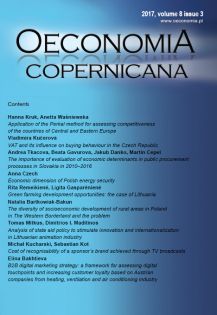VAT and its influence on buying behavior in the Czech Republic
VAT and its influence on buying behavior in the Czech Republic
Author(s): Vladimíra KučerováSubject(s): Micro-Economics, Economic policy, Fiscal Politics / Budgeting
Published by: Instytut Badań Gospodarczych
Keywords: Value Added Tax; price elasticity of demand buying behaviour; food retail; case study;
Summary/Abstract: Research background: Value added tax (VAT) is nowadays the most widely used indirect tax system in developed countries. Value added tax, is an instrument of fiscal policy and also a very important source of income for the state budget. It is one of the universal indirect taxes, which has a significant influence on the price level in the country. The European Union's system of value added tax on goods and services is primarily governed by "the 6th VAT Directive" set by the European Commission.Purpose of the article: The paper deals with the question of how changes in the rates of value added tax influence the buying behaviors of customers. Buying behavior could be expressed as decisions of customers about spending their own resources such as money, effort and time, on items related to their consumption in order to meet their needs.Methods: The area of the research is the Czech retail food market. Due to the nature of VAT, the influence of this tax on buying behavior was quantified by price elasticity of demand and indirect tax elasticity of demand, respectively. The article is conceived as a case study, according to the principles of R.K. Yin. The evaluation of buying behavior is based on real data, which deals with the volumes of sales and sales prices realized in a specific Czech retail chain, which associates more than 200 shops.Findings & Value added: The goal of the study is not only to propose the way to identify buyers' response to the changes in the VAT rate, but also to bring the knowledge about customers’ response to the realized changes, and finally to propose how to use this knowledge in a development of pricing strategy in case of further changes in the VAT rate.
Journal: Oeconomia Copernicana
- Issue Year: 8/2017
- Issue No: 3
- Page Range: 353-366
- Page Count: 14
- Language: English

